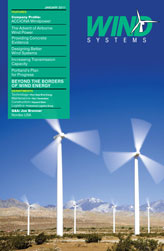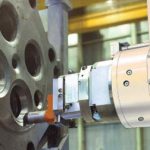Wind-based electricity generation has enjoyed rapid growth over the past 10 years, driven by government incentives and wind’s current status as the lowest cost, most scalable renewable energy option. New wind farms must be located in areas with excellent wind resources, and unfortunately these areas are often far from load centers and have weak transmission infrastructure. This creates a well-documented need for additional transmission capacity, which has been difficult to satisfy due to planning and permitting hurdles that can cause endless delays and cost escalations for new transmission projects. As solar plants increase in size, they will face increasing transmission challenges as well.
It is not always necessary to build new transmission lines to add transmission capacity, however, and technologies exist that enable increases in transmission capacity that cause little or no visible change to the existing transmission infrastructure. While no single technology will solve all transmission related challenges on its own, together these technologies will play an important role in enabling the increased penetration of renewables on the grid. Figure 1
Increasing Transmission Capacity
Many options exist for increasing capacity in the transmission grid, but not all options will find equal acceptance by all stakeholders. As a general rule, if a new right of way (ROW) is required for new transmission infrastructure, a smaller ROW will meet less external resistance than a larger one. Additionally, if an existing transmission ROW can be upgraded to increase capacity with only a small increase in footprint, it will meet even less resistance. In the best-case scenario, transmission capacity can be increased in an existing ROW without expanding the footprint of either the structures or the ROW itself.
Technologies are available today to fulfill this scenario, but each one has its own unique characteristics that make it effective in some situations and ineffective in others. In those cases where all of the requirements for deploying one of these technologies are met, they can offer considerable savings in costs, time, and effort. The technologies include Dynamic Line Rating (DLR), High Temperature Low-Sag Conductors (HTLS), Voltage Uprating, and Flexible AC Transmission Systems (FACTS).
Dynamic Line Rating
To avoid exceeding a transmission line’s thermal constraints, most lines have established a maximum power flow level that cannot be exceeded at any time. This static thermal rating is based on the worst-case scenario with respect to environmental conditions: a hot day with full sun and a very low wind that is typically assumed to be around 2ftps. If the line’s maximum power flow is exceeded under these conditions, the line could sag to the point where it would come into contact with trees, trucks, boats, or other nearby hazards.
However, power levels that would cause unacceptable sag in a transmission line under these conditions may not cause unacceptable sag on a cooler, cloudy, windy day, when the rising temperature caused by current through the line is offset by the colder operating environment and the cooling effect of the wind. Because the environmental conditions are almost never as unfavorable as those used to calculate the static thermal rating of a line, the line’s true maximum capacity is underestimated the vast majority of the time.
Dynamic line rating equipment provides the true maximum capacity of the line based on current environmental conditions, effectively enabling this capacity to be used for power transmission. The amount of capacity enabled in this way can be significant. Vendors of DLR equipment estimate that an increase of 10C in the ambient temperature can increase the rating of a line by over 10 percent, and an increase from no wind to a 1mps wind blowing at a 90-degree angle to the line can increase the rating by over 40 percent. Shadows caused by clouds tend to have a smaller effect, increasing the rating by a couple percent. Rain can have a large impact on the rating as well.
DLR requires additional equipment to be added to the line and an information link to be made to the transmission control system, but it uses the existing line in the existing right of way. Some DLR technologies require the line to be taken out of service as they are installed or calibrated, which can cause disruption, particularly because the technology is often installed on lines that are very heavily loaded. Figure 2
One tradeoff that must be considered when evaluating DLR and other technologies that allow increased current through existing lines is that the losses in transmission lines increase as the square of the current through them. Therefore there is a penalty for running high currents through lines, which makes “high current” technologies more attractive when those higher currents will only be required on a temporary basis, such as during periods of peak demand or when other lines fail.
High Temperature Low-Sag Conductors
Another option for overcoming excessive sag caused by overheating is to reconductor existing transmission lines with high-temperature low-sag (HTLS) conductors. These conductors have special cores that, like traditional conductors, heat up when carrying large amounts of current. However, unlike traditional conductors, they do not sag nearly as much when operating at high temperatures. As a result, a traditional conductor can be replaced by an HTLS conductor with the same weight and diameter, and which uses the existing transmission towers and ROWs, for a significant increase in the line’s thermal rating.
Then why not use them all the time? HTLS conductors are significantly more expensive than traditional cables (costing 1.2 to 6 times more), although when they are used to upgrade an existing line this additional cost is offset by the savings associated with reusing the same right of way and towers, and reduced (or, in some states, eliminated) permitting costs. Additionally, reconductoring does involve construction crews working on a right of way, even though the right of way itself won’t be expanded. And like DLR, the advantage from HTLS conductors comes from enabling operation at higher currents, which can lead to unacceptably high losses. Newer HTLS conductors that use composite materials have a higher conductivity than conventional cables, which reduces the loss penalty at higher currents but does not eliminate it completely. Figure 3
Even with those drawbacks, there are situations where HTLS conductors can play a valuable role, such as long spans over rivers that are particularly sensitive to sag. They can also improve the reliability of the grid without requiring additional lines to be added. In this case, the additional capacity enabled by the ability to carry high currents in the HTLS cable is held in reserve, allowing other lines in the area to increase their capacity. If one of those other lines fails, the HTLS cable can carry the additional load until the down line is repaired. Figure 4
Voltage Uprating
Voltage uprating involves increasing the voltage of a transmission line to the next standard voltage level, which increases the power that can be transmitted through the line without increasing the current. By taking this approach, the line is not brought any closer to its thermal rating and losses are not increased.
Some transmission lines, usually those built years ago, have been overbuilt to the extent that their voltage can be increased with only relatively minor changes to the line itself (e.g., new transformers but reuse of the conductor). In this best-case scenario, an increase in the corona of the line and the line’s electromagnetic field (EMF) may still require an increase in the ROW for the line, which can be very difficult to obtain. However, if those challenges do not apply or can be overcome, voltage uprating is a very attractive option for increasing the capacity of a line.
In most cases, unfortunately, voltage uprating will require a larger conductor or bundled conductors, and larger transformers, among other changes. In this case, permitting and construction crews will be required to install the new conductor and either install new towers or modify the existing towers. The one advantage of rebuilding the line in this way is that it may be possible to use a compact design or bundle the conductors so that the corona and EMF do not require an expanded ROW. This reduces the impact of the upgrade on the footprint of the transmission line and could make planning and permitting easier while reducing costs.
One of the challenges of voltage uprating is that it must be undertaken in relatively large steps: even if only a little more voltage is required to meet additional power flow requirements, the voltage must be increased all the way up to the next standard voltage level if voltage uprating is undertaken. While a small voltage increase may have allowed the use of the same ROW, jumping all of the way up to the next voltage level is likely to push the line beyond the existing ROW limits. As a result, voltage uprating can be an attractive option when large jumps in power are required, but other options may be preferable when only an incremental increase is needed.
Flexible AC Transmission Systems
Flexible AC Transmission System (FACTS) devices play a key role in ensuring transmission system stability and also can increase the amount of capacity available at key points in the transmission grid by routing power flows.
Static VAR compensators (SVCs) and STATCOM devices both provide dynamic reactive power to serve as voltage support to counteract changes to system voltage, including rapid changes such as those due to a line fault. The primary purpose of these devices is to improve system stability, and they do not directly increase the capacity available on a given line. However, with improved control over system stability, it is possible to run transmission lines closer to their limits, so these devices indirectly enable increased transmission capacity in the system.
Series compensation, on the other hand, can be used to increase the available capacity on a given path, although this also occurs in an indirect manner. When there is more than one path between a generator of electricity and a load, the electrical power flows preferentially through the transmission grid down the path of least impedance. Series compensation can reduce the impedance of a line, either statically or dynamically, to increase the load carried by that line and reduce the load carried by parallel paths.
Unified power flow controllers (UPFCs) and phase-shifting transformers both have the ability to directly route real power flows through the transmission network, while UPFCs have the added ability to offer voltage support through functionality similar to that of SVCs and STATCOM devices. UPFCs and phase-shifting devices can be used to route power away from lines that require additional capacity, assuming there is available capacity in a parallel line.
Accelerating Growth in Renewables
While technologies that increase transmission capacity without requiring the acquisition of new rights of way or the undertaking of major construction projects will not always meet the capacity requirements of new renewable energy projects, there are situations where they can help by reducing costs, accelerating timelines, and easing permitting burdens. These technologies provide options to developers that will enable faster growth in renewables while avoiding resistance to new projects that new transmission lines can foster.








































